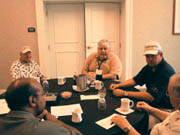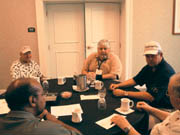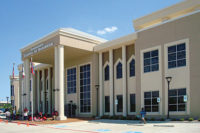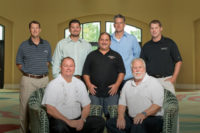During CLAPCA's Beach Blast Seminar, held at the Kingston Plantation, in Myrtle Beach, S.C., this past September, five contractors joined Walls & Ceilings to talk about insurance, mold, their concerns as contractors, and their triumphs and aspirations as the association that serves the North and South Carolina states.
All key CLAPCA board members joined the magazine for this discussion. Among those who attended were Jerry Baker, of Precision Walls Inc., of Raleigh, N.C.; Danny Bonnell, of Commercial Systems Inc., of Myrtle Beach.; Frank Guidera, of Performance Exteriors, of Charlotte, N.C.; Floyd Gordon II, owner of Gordon & Associates, of Columbia, S.C., and current president of CLAPCA; and J.R. (Dick) McCallum, retired plastering contractor of 47 years, of Carrboro, N.C.
W&C: What is CLAPCA doing about the insurance situation right now? Is it working on its own? Is it working with EIMA?
Gordon: Well, we thought we had an insurance program that was brought to us from the Georgia Lath and Plastering Association. They formulated with an insurance group, but we kept getting put off every month so it looks like we're going to have to go in a different direction. We're going to have to get with some other associations and probably try to end up getting self-insured.
W&C: What other associations?
Gordon: Florida (FWCCA), Texas (TLPCA), NWCB. We're going to look at their concerns, see what they've done to try to alleviate the insurance problem and go from there.W&C: Have you been able to approach the local government or the Commissioner of Insurance?
Gordon: We've had a representative from the Insurance Commission at two or three of our meetings and basically, we've tried to do what he said to do: get training in place so underwriters can look at the AWCI training and make sure everyone has some type of insurance, and look at how we're doing business and how other states are doing business.
Guidera: I know that insurance is one of the highest costs. In every direction that we turn, it's basically general liability workmans' comp. In Charlotte, we're forced to pay a percentage of hospitalization for our employees. There's an unfounded stranglehold on us. We have had one of the commissioners-or one of the members of the commission-here, and he seems to be behind us 100 percent but I don't see any change, as Floyd said.

W&C: Being a part of the association is important to the fight, isn't it?
Guidera: It is part of the fight but it seems we don't have the clout. We don't have enough money to get where we need to be. It's all about money, every single part of it: the insurance people giving us the insurance; the underwriters underwriting the insurance, and the people that we get our insurance from, our agents, calling us on Friday to say, "You know your premiums are going up in a couple weeks. We need to get that $35,000 (or $45,000)," and that's tough.Our insurance has increased for my small company, which is a fraction of what these guys pay (the other contractors at the round table). My insurance two years ago for general liability was $5,000 per year, now it's $50,000.
And I'm limited: I'm told what I can do and what I can't do in order to feed my family and make a living. I have no competition. I don't believe there are any members here who do what I do: troubleshoot. A SEAL team, if you will, that comes in and takes care of problematic work, insurance problems. I personally work for some of the largest insurance companies in the world, and can tell you right off the get go, that I've saved these companies an average of $20 to $30 million in lawsuits, every single year. Does it afford me any break? No, it doesn't.
I know there's a limit to what CLAPCA can do and I know there's a willingness to do it. I just don't know if we haven't already tried it by writing letters and other things. There's definitely a fog against the stucco/plastering trade.
W&C: What do you mean by "a fog"?
Guidera: What I mean is that when we go out to do our job there are certain commissioners, who take it upon themselves in certain counties, to dictate what will go on in that county, without consulting anyone else, and can actually stop us from doing our job; won't even allow what we do for a living there because it's extremely simple and I make no bones about it: It's because of ignorance of people who do not understand the mechanics of a building. Water sinks to the lowest level. When water enters into a building, you need to let it exit the building. And no matter what the cladding is-whether it's a TP or a condom-you got to exit it into that atmosphere. And because if the cladding is EIFS, stucco or brick, and it gets behind the framing, all the barrier in the world doesn't help you. But yet, because stucco is so easy to repair, they want to say we're a bad product.I saw you listening to the gentlemen of Moisture Warranty, the largest building warranty company in the country. He told you last night that the major problems that the new class action suit against window manufacturers is in what cladding? It's a brick cladding. I also repair brick houses and stone houses, and I can tell you unequivocally, there's as much damage behind stone and brick when the water gets behind those areas as EIFS. I work for some of the largest engineering firms in this several-state area and I've posed this same question over and over: If you were to list all the products-EIFS, stucco, brick, whatever cladding you want to put up there-how many have water damage problems? And they'll tell you, "All of them." And I'll ask the next question: Where does EIFS play in that? They'll say, "Of all the claddings, EIFS is the one of the lowest problems with water intrusion."
Baker: The insurance problem with Precision Walls is a major issue. Contrary to most members of CLAPCA, Precision Walls, along with two or three others, is really a drywall contractor. So, EIFS is a secondary thing.
So, when the issue of insurance comes up, and I'm not sure I understand what the relationship is, but the relationship demands that Precision Walls, when they talk to us and we talk to them about insurance for this industry, the rates that we pay are quoted astronomical. We're talking about a company that has 1,200 to 1,500 employees. So, our insurance dollar spent within a year in our budget was a huge number. We faced a decision when we were informed of our renewal dates and what was going to be imposed on us. We actually sat down and made a decision whether or not we were going to stay in the (EIFS) industry or not. Would it pay for itself? Is it worth the hassle? Only through communication with the people in the company who make the final decisions was that decision made.
It obviously raises the ire of everybody in this industry. The reason is that we as a group, we as an industry, have been singled out by the insurance industry, completely and totally. The willingness of the industry, or the insurance companies, to evaluate where the actual problem lay, never occurred. The reason they never did that is because actuaries who determine rates look at incidences and they don't say that these incidences come from a commercial industry job or this job comes from a residential EIFS. If you pull all the incidences that the insurance companies experience to determine this high rate that they're putting on us, 99.9 percent will fall on the residential industry. And if these same people, and again we're still talking about insurance because insurance is the thing that's kicking us in the butt right now, the incidences all come from the residential jobs, where typically, there are no architects. Typically, you're talking about a residential builder who has no one looking over his shoulder. Once he starts the job, there's no architect there. No one looks over his job except a building inspector. And I'm not going to voice anything in that tape recorder addressing the building inspecting industry. I'm going to tell you that in the residential building industry as a whole, there's a major, major problem.

W&C: Is EIFS still used in the residential market(in the Carolinas)?
McCallum: On a limited basis. I happen to know that the most expensive area is the Governor's Club, out of Chapel Hill. We're talking about $3 or $4 million homes out there. What contractors have done is found people that they know who are well qualified to go out and do these. And they've had no troubles whatsoever out there.
One thing I'd like to address before we go any further. North Carolina Central University, in Durham, N.C., has a mold problem that's going to cost them $3 million to correct. The dormitories are less than three years old. And this is not from intrusion from the outside, but intrusion on the inside. The mechanical systems that they use are generating the mold from within the buildings. I think this is something we could we jump on too, and say, "Look, we're not the bad boys. You've got to look at the overall picture." This is the perfect position to put us on the offensive rather than the defensive on the insurance and everything else. That's $3 million the state of North Carolina's going to spend to get that thing straightened out.
W&C: Obviously, mold is an issue here. But we're not talking toxic mold.
Bonnell: The insurance certainly is impacting our industry. On the other side, it's cleaning up our industry because one of the problems we've had over the years, we've had an awful lot of people involved-in our industry-who are self-serving, don't really care about the customers so to speak. They're in it for the quick buck, not the long-term reputation like the firm Jerry's with, Frank, Mr. McCallum, and Floyd's a second/third-generation family. I look at the insurance, we're paying one hell of a premium and not everyone's stepping up to the plate. But I think there's an opportunity to turn the corner and get the right information.W&C: Could you give me an example of how quick your premiums spiked and when?
Bonnell: Overnight.
Baker: It was overnight. I wanted to comment on the residential topic. Five years ago, the residential volume of EIFS was astronomical. But there were two problems: One problem was in the residential but it also had the same problem in the commercial. In the residential market, you got a builder who wants to build as many houses as he can. In my particular area in Raleigh, there's a tremendous housing boom going on. I would say that a good 60 percent of the houses being built in my market five years ago had EIFS on ‘em. One particular distributor was shipping a truckload of material in to a particular applicator a week. That's 40,000 square feet.
Bonnell: An average home will have 3,500 to 4,200 square feet.
Baker: So, the volume is great. How about this applicator going in, and doing a house, and the house is framed, and the applicator comes in on Monday and starts hanging board. This same applicator, next day he's wrapping it, putting corners, implants on it, next day he's putting the finish on it, next day is taking the scaffold down, and in five days he's gone. I'm here to tell you, "no." He's doing a truckload a week. No caulking, no expansion joints to the floors, on and on and on. I'm telling you no flashing, no kick-up flashing, no caulking, no nothing, and now they want to say, "It's an EIFS problem." So, why did that happen? Because everyone wants something for nothing. All of sudden, this desire to have something for nothing bit ‘em in the butt.
When I started this business in 1979, I looked at buildings that were done in Europe. In Germany, in the early '50s, and they looked the same in the '70s as they did in the '50s. Why? Because they did it right. There are buildings that are being built in Myrtle Beach, North Carolina, South Carolina, that are built to last a year. Isn't that right Danny?
Bonnell: Absolutely.
Baker: They're built to last one year. They are putting material after material, putting finishes directly over gypsum sheathing in a lot of buildings here: No foam, because all they want is for it to last a year. And when the lawsuits occur, they say, "Your product is not worth a flip." Wrong. How can I be in business since 1979 doing this and not have a failure? Why are my insurance rates getting jacked? The insurance industry's not willing to separate residential from commercial without looking at the number of incidences here and there, and then letting price drive it. You can't blame them for taking advantage of it, though unfortunately, the price is driving people out of business.
Maybe we'll be able to get rid of the less desirable applicators, because they won't be able to join our group and they won't be able to pay these insurance rates.
W&C: What kind of support have manufacturers given? Tech support? Sales support?
Baker: The manufacturers have obviously been of assistance. But you know what, it's not because they want to. It's their livelihood.
McCallum: I hate to say this but generally it is the lack of training by the manufacturers that has caused 90 percent of our problems. And that all could be cured.
Bonnell: AWCI has a training program that Frank (Guidera) and I were the original team that put it together. I just sent 17 people through the program in the last two days. Last year, I sent 24 people through. I paid for two days for them to sit in class, out of my pocket, paid for their participation. They work for me. There's no guarantee all of them will stay with me. The 24 I sent last year are still with me now. I have a work base that has been with me a long time. The manufacturers will endorse the program, but they won't make it mandatory. Now you can't move the program forward if there's not a cost or a penalty. If you want to move the industry up, you have to raise the bar. But you've got somebody in the organization ... a one-day session of wet wall, where you go and get a hot dog and BS and leave. The guy that's out there right now (in the adjacent building to where the interview is taking place) he's the one that has to know what we're doing. He's the one that going behind and checking. And I've come a long way. We're doing things a lot different today than we were when we first began.
When I sat down last October and they laid that bill (insurance premium) in front of me, I had leave the room, stand there a few minutes and decide whether I wanted to go back in that room and write a check. That's a hard choice because you want to stay in business or you're going to get out. And that's what I had to think when I went outside that door. You commit yourself to $200,000 to a premium that used to be $22,000 and basically, I worked seven months last year for nothing. That was to pay for my insurance. And I'm not negative-I love this industry, it's been good to me. That's why we're still fighting. And that's why we're here. But it's hard to get everybody to have that conviction. But you're going to have to force it to the table. And they can throw all the money they want in marketing and throw all they want at, say we're going to do a captive insurance program, but they don't control the level of quality where it needs to be.
In the state of South Carolina, we had a bill that came out to ban EIFS, we went in and got it pulled back. One of the things that we brought to the table and the senator was, "For $25, a guy can go into business and go out and do a $1 million-home, have no training, no financial-he doesn't need anything except $25 to get this little card and someone will sell him an EIFS product and he can go do a $1-million home. And the senator sitting there, looked at us and said, "Are you serious?" And they went and checked and he thought, "He is serious." I'm not saying we're the only industry that's bad. But if you look at electrical, there's licensing, plumbing ....
McCallum: The South Carolina General Contractor's License is probably the third hardest in the United States to acquire. The General Contractor's is an unlimited license. I happen to know because I carried it for Precision Walls for a number of years. And I got in right after they changed that thing and it took me two sessions to get through it. But it is tough! And if it got just as tough on subcontractors as it did on the general contractors we'd see a whale of difference in our industry. But it's going to take the manufacturers and everybody in that whole field to do it.
Baker: Without question, manufacturers obviously are the lifeblood of our industry, but nobody can talk out of both sides of his mouth. We have had major players in this industry who speak about quality and 10 minutes later we find their products on building supply shelves. Now, when I say major manufacturers I'm talking about Fortune 500 companies. I'm not naming names. But that's the kind of thing that we have to fight. Because when it goes on a building supply shelf, Henry out here, who's pouring coffee out there, can go over to Home Depot and pick up a can of synthetic stucco. That should never have happened. So what Danny has said, what Dick has said, it's critically important that everybody in the chain, the applicator, the guy who is promoting the product, to the distributor and manufacturer, all the way up, they all have to be a part of it.
Bonnell: Credibility with the manufacturers, they're the ones that have to make the first sacrifice, is the way I look at it. They have to say, "Hey, this is what we're going to do. These are our requirements," to the distributor. The distributor is then going to say, "You know, I would've liked to have sold a job over there. But you know the guy who's going after it won't be here three years from now. He's not going to be here." Let the sale go. The sad part of our industry is, the three people who turn that job down, there are six more standing on the street corner, ready to sell to that guy.
W&C: What's in the future for CLAPCA? What are (this year's) goals?
Floyd: We have a great opportunity to get that bill passed. We've been sending that in to the legislator for the past four years. The homebuilders are very receptive now to the licensing requirement. We're starting to develop a good relationship with him. We are lucky this past year to have gotten a bill passed that will affect all construction in South Carolina. If the homeowner has a problem, he has to go to the builder first before litigation. And that's a major step forward. He has the first opportunity to make the repair or have someone else make the repairs, at his expense, before litigation begins. And this has worked out with the help of the legal system in South Carolina. Lawyers came to the table and said, "Let's give them the opportunity first." That's one goal to get our bill passed.
We're not just an EIFS association, we're a plastering association. There are other products out there that we'd like to educate the plastering community about. Manufacturers have gone in other directions with special codes. Veneer plastering has been a big seller in the northeast. I'd like to see us push veneer plastering in the Carolinas. It's a beautiful system. A lot more durable than just drywall. You can't be a single-dimensional firm. The way the system is working now, you've got to be multi-dimensional. We don't want to just say, "This is an EIFS association, that's all we're going to talk about, that's all we're looking at." No, we're also a plastering association, and that's what we'd like to be recognized as.
W&C: How about the North Carolina point of view regarding its goals?
Baker: I guess my pet peeve with this organization, the source of my irritation, is that we have a huge number of plastering contractors in the states of North and South Carolina. The number of people in this organization, CLAPCA, are people who participate and come to these meetings spend all hours of the night and drive hundreds of miles to go to meetings. We've got 100 looking after 3,000, and that's my major pet peeve. These other people that I'm talking about go out and make money and come home and buy groceries, and pay their mortgage bills, and spend their money on vacations on the money that they make in this industry. If it were not for groups like this, they wouldn't be in this. And I'll give you a specific drawback.Probably 10, 11 years ago, this industry also faced what was called radiant heat. And thank goodness for EIMA. If it were not for EIMA, and a group of guys willing to get on a plane and fly to Denver, we'd be out of business. Radiant heat would've shut us down. We're sitting here in the states of North and South Carolina, facing somebody or a group of people trying to put us out of business.
Ten guys can't do it by themselves-we need help. We beg, we send out flyers, invitations, golfing; we do everything but bomb to get them here. But every time we come to this meeting, I'm looking at exactly the same people. And it's amazing that the ones who come to this meeting, are the same ones that come to EIMA. The same major players, doing exactly the same thing. Trying our damndest to save the industry for two states. And people just don't hear. The philosophy of "don't worry so much, someone will take care of it" is pervasive.
Everybody's who's not a member, not at this meeting, and that is in the plastering business in these states, is doing a disservice to the industry. I don't care who they are. We're talking major companies who have the resources to help and they turn their backs.





Report Abusive Comment